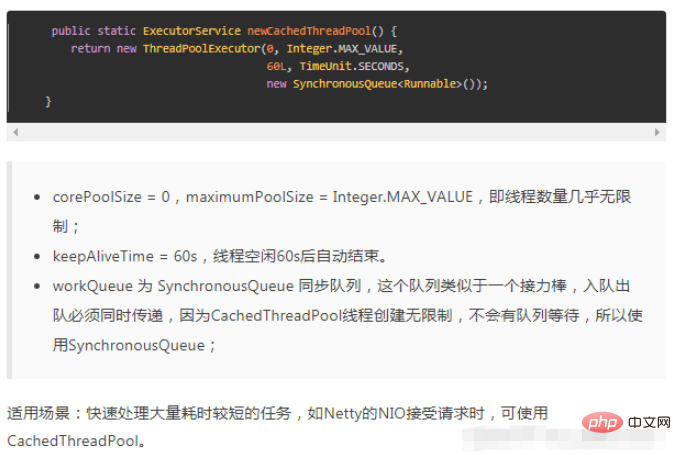newSingleThreadExexcutor:單執行緒數的執行緒池(核心執行緒數=最大執行緒數=1)
newFixedThreadPool:固定執行緒數的執行緒池(核心執行緒數=最大執行緒數=自訂)
newCacheThreadPool:可快取的執行緒池(核心執行緒數=0,最大執行緒數=Integer.MAX_VALUE)
newScheduledThreadPool:支援定時或週期任務的執行緒池(核心執行緒數=自訂,最大執行緒數=Integer.MAX_VALUE)
上面四種執行緒池類別都繼承ThreadPoolExecutor,在建立時都是直接回傳new ThreadPoolExecutor(參數),它們的差別是定義的ThreadPoolExecutor(參數)中參數不同,而ThreadPoolExecutor又繼承ExecutorService介面類別
newFixedThreadPool
定義:
xecutorService executorService=Executors.newFixedThreadPool(2);

##缺點:使用了LinkBlockQueue的鍊錶型阻塞隊列,當任務的堆積速度大於處理速度時,容易堆積任務而導致OOM記憶體溢出
newSingleThreadExecutor
定義:ExecutorService executorService =Executors.newSingleThreadExecutor();

 ##可知,fixedExecutorService的本質是ThreadPoolExecutor,所以fixedExecutorService可以強轉成ThreadPoolExecutor,但singleExecutorService與ThreadPoolExecutor沒有任何關係,所以強轉失敗,故newSingleThreadExecutor()建立後,無法再修改其執行緒池參數,真正做到single單一執行緒。
##可知,fixedExecutorService的本質是ThreadPoolExecutor,所以fixedExecutorService可以強轉成ThreadPoolExecutor,但singleExecutorService與ThreadPoolExecutor沒有任何關係,所以強轉失敗,故newSingleThreadExecutor()建立後,無法再修改其執行緒池參數,真正做到single單一執行緒。
缺點:使用了LinkBlockQueue的鍊錶型阻塞隊列,當任務的堆積速度大於處理速度時,容易堆積任務而導致OOM記憶體溢出
newCacheThreadPool
#定義:ExecutorService executorService=Executors.newCacheThreadPool();##缺點:SynchronousQueue是BlockingQueue的實現,它也是一個佇列,因為最大執行緒數為Integer.MAX_VALUE,所有當執行緒過多時容易OOM記憶體溢出
定義:ExecutorService executorService=Executors.newScheduledThreadPool(2);
##源码: public static ScheduledExecutorService newScheduledThreadPool(int corePoolSize) { //ScheduledThreadPoolExecutor继承ThreadPoolExecutor return new ScheduledThreadPoolExecutor(corePoolSize); } public ScheduledThreadPoolExecutor(int corePoolSize) { //ScheduledThreadPoolExecutor继承ThreadPoolExecutor,故super()会调用ThreadPoolExecutor的构造函数初始化并返回一个ThreadPoolExecutor,而ThreadPoolExecutor使实现ExecutorService接口的 //最终ScheduledThreadPoolExecutor也和上面几种线程池一样返回的是ExecutorService接口的实现类ThreadPoolExecutor super(corePoolSize, Integer.MAX_VALUE, 0, NANOSECONDS, new DelayedWorkQueue()); }
線程池有哪幾個重要參數? ThreadPoolExecutor建構方法如下:

 #keepAliveTime是指目前執行緒數位於[核心執行緒數,最大執行緒數] 之間的這些非核心執行緒等待多久空閒時間而沒有活乾時,就退出執行緒池;
#keepAliveTime是指目前執行緒數位於[核心執行緒數,最大執行緒數] 之間的這些非核心執行緒等待多久空閒時間而沒有活乾時,就退出執行緒池;
等待丟列的大小與最大執行緒數是沒有任何關係的,線程創建優先權=核心線程> 阻塞隊列> 擴容的線程(當前核心線程數小於最大線程數時才能擴容線程)
假如核心線程數5,等待隊列長度為3,最大線程數10:當線程數不斷在增加時,先創建5個核心線程,核心線程數滿了再把線程丟進等待丟列,等待隊列滿了(3個線程),此時會比較最大線程數(只有等待丟列滿了最大線程數才能出場),還可以繼續創建2個線程(5 3 2),若線程數超過了最大線程數,則執行拒絕策略;
假如核心執行緒數5,等待佇列長度為3,最大執行緒數7:當執行緒數不斷在增加時,先建立5個核心線程,核心執行緒數滿了再把線程丟進等待丟列,當等待隊列中有2個線程時達到了最大線程數(5 2=7),但是等待丟列還沒滿所以不用管最大線程數,直到等待丟列滿了(3個阻塞線程),此時會比較最大線程數(只有等待丟列滿了最大線程數才能出場),此時核心等待丟列=5 3=8>7=最大線程數,即已經達到最大執行緒數了,則執行拒絕策略;
如果把等待丟列設定為LinkedBlockingQueue無界丟列,這個丟列是無限大的,就永遠不會走到判斷最大線程數那一步了
可以使用有界队列,自定义线程创建工厂ThreadFactory和拒绝策略handler来自定义线程池
public class ThreadTest { public static void main(String[] args) throws InterruptedException, IOException { int corePoolSize = 2; int maximumPoolSize = 4; long keepAliveTime = 10; TimeUnit unit = TimeUnit.SECONDS; BlockingQueue workQueue = new ArrayBlockingQueue<>(2); ThreadFactory threadFactory = new NameTreadFactory(); RejectedExecutionHandler handler = new MyIgnorePolicy(); ThreadPoolExecutor executor = new ThreadPoolExecutor(corePoolSize, maximumPoolSize, keepAliveTime, unit, workQueue, threadFactory, handler); executor.prestartAllCoreThreads(); // 预启动所有核心线程 for (int i = 1; i <= 10; i++) { MyTask task = new MyTask(String.valueOf(i)); executor.execute(task); } System.in.read(); //阻塞主线程 } static class NameTreadFactory implements ThreadFactory { private final AtomicInteger mThreadNum = new AtomicInteger(1); @Override public Thread newThread(Runnable r) { Thread t = new Thread(r, "my-thread-" + mThreadNum.getAndIncrement()); System.out.println(t.getName() + " has been created"); return t; } } public static class MyIgnorePolicy implements RejectedExecutionHandler { @Override public void rejectedExecution(Runnable r, ThreadPoolExecutor e) { doLog(r, e); } private void doLog(Runnable r, ThreadPoolExecutor e) { // 可做日志记录等 System.err.println( r.toString() + " rejected"); // System.out.println("completedTaskCount: " + e.getCompletedTaskCount()); } } static class MyTask implements Runnable { private String name; public MyTask(String name) { this.name = name; } @Override public void run() { try { System.out.println(this.toString() + " is running!"); Thread.sleep(3000); //让任务执行慢点 } catch (InterruptedException e) { e.printStackTrace(); } } public String getName() { return name; } @Override public String toString() { return "MyTask [name=" + name + "]"; } } }
运行结果:

其中7-10号线程被拒绝策略拒绝了,1、2号线程执行完后,3、6号线程进入核心线程池执行,此时4、5号线程在任务队列等待执行,3、6线程执行完再通知4、5线程执行
以上是Java自備的四種執行緒池是什麼?的詳細內容。更多資訊請關注PHP中文網其他相關文章!




